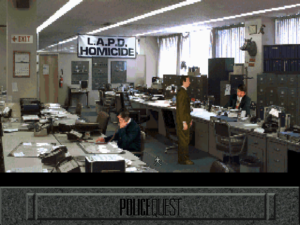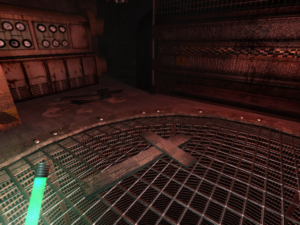PQ4: Stereotypes
For as long as Sierra had the ability to do something resembling acting with its sprites, that acting was hammy, all broad gestures and exaggerated accents. The broad gestures in particular are often the complete focus of the game: when the engine wants to play a special animation, be it something as minor as an actor emoting in the middle of dialogue, it’ll temporarily suspend interaction while you watch it, like it’s a mini-cutscene. I suppose it stems from the low resolution. 320×200 doesn’t leave a lot of room for subtlety, unless you’ve got a skilled pixel artist — stylized figures can suggest more than they depict. But the photographic approach of PQ4 makes that sort of minimalism impossible. There’s irony for you: the style is presumably supposed to lend the game a greater realism, but the end result is extreme theatricality.
The exaggerated accents are harder to excuse, but I’ve seen them try. I recall an interview or developer commentary video or something about The Dagger of Amon Ra that explained that they made every character in that game speak a distinct dialect so that it would always be obvious who was speaking in the scenes where you eavesdropped on unseen conversations, even if you had the sound turned off and were only seeing the dialogue as text. But that’s a highly-specific reason that only applies to the circumstances in the one game. Also, that game was set in the 1920s, and thus could be seen as drawing from period cinema. PQ4 has ambitions of being gritty and modern and ripped-from-the-headlines, and that makes the dialect seem particularly unfortunate. The initial murder takes place in South Central LA, where the possible witnesses are predominantly black. Their dialogue is all strained slang and “sheeit”, a white boy’s impression of a stereotypical urban negro.
Not that the white characters are much more convincing. Some of the cops, despite living in California, have the kind of exaggerated New York accent that I never actually heard while I was living in New York. The jolly morgue attendant tells ghoulish “jokes” at an approximate six-year-old level of humor, and laughs uproariously at the end of each one, always with the same animation. The receptionist at the morgue is Kooky. She even has her own kooky music that plays as she waves her kooky wave and talks to you in her kooky voice. Someone thought this was important enough to devote an entire scene to it, peripheral as it is to the investigation.
I don’t know how much of the game content Daryl Gates really wrote. Much of the above seems like standard Sierra goofiness. The pushy reporter who goes out of her way to cast the police in a bad light out of petty vindictiveness seems like an obvious thing to blame on him, though. It’s worth noting how that starts: you encounter her and her cameraman outside HQ and have no choice but to push her aside to progress. Even if you try to talk to her, even if you want to answer her questions to the extent permitted (or just provide enough content-free sound bites to satisfy her), all you say is “No comment”. Are we to take it that the police don’t even have the option of talking to the press? Whatever the case, it must be for a good reason, because the police just don’t do anything unjustified in this game. That’s their stereotype: the knight in blue. Not that they’re perfect in every way, but there doesn’t seem to be any notion that systemic problems like corruption or abuse of authority or even simple racial bias exist. There’s just individual weakness of character. The cop whose murder kicks off the whole story is said to have been under stress, and possibly even developed a substance abuse problem of some sort. Why? Because he couldn’t stand all the crime. He just couldn’t bear to see the good people of the city hurting each other so much. Seriously.
 Comments(1)
Comments(1)

